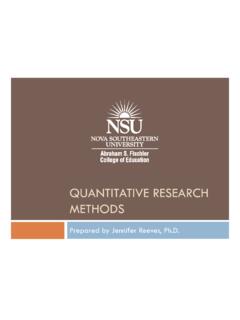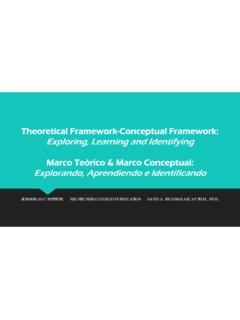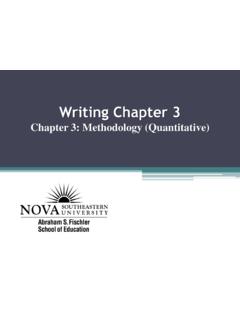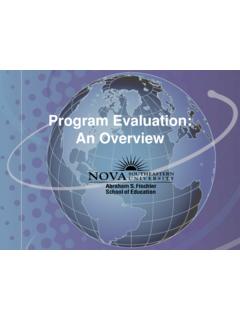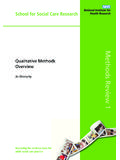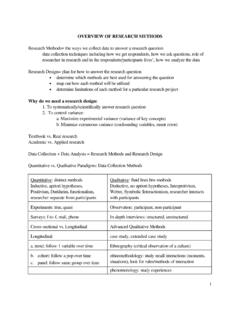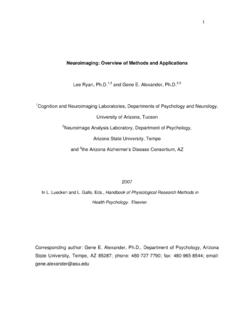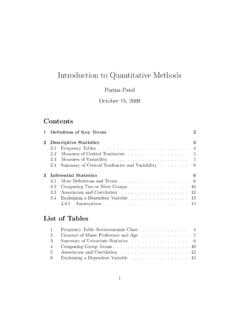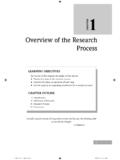Transcription of Overview - education.nova.edu
1 Overview Mixed methods research , Defined Quantitative research Qualitative research When to use Mixed methods research Types of Mixed methods research Designs Key Characteristics Steps in Conducting a Mixed methods study Evaluating a Mixed methods studyMixed methods research , Defined A mixed methods research design is a procedure for collecting, analyzing, and mixing both quantitative and qualitative research and methods in a single study to understand a research problem. To utilize this design effectively, you must understand bothquantitative and qualitative research . Philosophical ApproachesCreswell, J. (2012).Educational research : Planning, conducting, and evaluating quantitative and qualitative research (4thed.).Upper Saddle River, NJ: Pearson Education. QuantitativeResearch A type of educational research in which the research decides what to study; asks specific, narrow questions, collects quantifiable data from participants (a large number of participants); analyzes these numbers using statistics; and conducts the inquiry in an unbiased, objective manner.
2 Postpositivism singular reality; objective; deductiveQuantitativeResearch (cont d) Generally attempts to quantify variables of interest; questions must be measureable. Example: What is the relationship between graduate students level of interaction, measured by the number of hits in the course, and students grades in an online research methods course?QuantitativeMethodology Generally involves collecting numerical data that can be subjected to statistical analysis Examples of data collection methodologies Performance Tests Personality Measures Questionnaires (with closed-ended questions or open-ended but transferred to quandata) Content Analysis The data is generally referred to as hard dataQualitativeResearch A type of educational research in which the researcher relies on the views of participants; asks broad, general questions; collects data consisting largely of words (or text) from participants; describes and analyzes these words for themes; and conducts the inquiry in a subjective, biased manner.
3 Constructivism multiple realities; biased; inductiveQualitativeResearch (cont d) There are times we wish to know not how many or how well, but simply how (Shulman, 1988, p. 7). Example: What are the factors that influence a graduate students experience in an online research methods course? QualitativeMethodology Generally involves listening to the participants voice and subjecting the data to analytic induction ( , finding common themes) More Exploratory in nature Examples of data collection methods Interviews Open-ended questionnaires Observations Content analysis Focus GroupsSteps for Conducting a Mixed methods StudyDetermine if a mixedmethods study isfeasibleDevelop quantitative, qualitative, and mixed methods questionsCollect quantitativeand qualitative dataAnalyze data separately orconcurrentlyWrite the report as a one-or two-phasestudyIdentify the data collection strategy andtype of designIdentify a rationale for a mixed methodsstudyStep 1 Step 2 Step 4 Step 3 Step 5 Step 6 Step 7 PrioritySequenceVisualizationWhen to Use Mixed methods Designs When both quantitative and qualitative data, together, provide a better understanding of your research problem than either type by itself.
4 When one type of research (qualitative or quantitative) is not enough to address the research problem or answer the research questions. Pragmatism practicality; multiple view points; biased and unbiased; subjective and objectiveCreswell, J. (2008).Educational research : Planning, conducting, and evaluating quantitative and qualitative research (3rd ed.).Upper Saddle River, NJ: Pearson Education. When to Use Mixed methods (cont d) To incorporate a qualitative component into an otherwise quantitative study To build from one phase of a study to another Explore qualitatively then develop an instrument Follow-up a quantitative study qualitatively to obtain more detailed informationCreswell, J. (2012).Educational research : Planning, conducting, and evaluating quantitative and qualitative research (4thed.).Upper Saddle River, NJ: Pearson Education. Mixed methods research Methodology Utilizes both quantitative and qualitative data collection methodologies.
5 Examples Interviews and Questionnaires Performance Tests and Observation Questionnaires and follow up Focus groups Document analysis, Performance Tests, Questionnaire, and InterviewsWhat Is Mixed methods research ?A mixed methods research designis a procedure for collecting, analyzing, and mixing both quantitative and qualitative research and methods in a single study to understand a research problem. Key Characteristics of Mixed methods Designs: Rationale Rationale Test findings of first phase Explain results of first phase in more detail Provide a more complete understanding than either quantitative or qualitative alone Collecting both quantitative and qualitative data Numeric data Text dataMixed methods LegendNotationDefinedQUANQ uantitatively driven driven data is secondary to data is secondary to quantitative data.+Indicates that quantitative and qualitative data are collected concurrently. Indicates that quantitative and qualitative data are collected Characteristics of Mixed methods Designs: Priority and Sequence Priority Equal weight QUAN carries more weight than qual QUAL carries more weight than quan Sequence Collect both quantitative and qualitative data at the same time Collect quantitative data first, followed by qualitative data Collect qualitative data first, followed by quantitative data18 Key Decisions In Choosing A Mixed methods Study The level of interaction between the quantitative and qualitative strands The priority of the strands The timing of the strands Where and how to mix the strands20 The Convergent Parallel DesignCompare or relateInterpretationQuantitativeData Collectionand AnalysisQualitativeData Collectionand Analysis21 The Convergent Design The researcher.
6 Collects quantitative and qualitative data concurrently Analyzes the two data sets separately Mixes the two databases by merging the results during interpretation (and sometimes during data analysis)22 Purposes for the Convergent Design Obtain a more complete understanding from two databases Corroborate results from different methods Compare multiple levels within a system23 When to Use the Convergent Design Choose this design if: Need to collect both types of data in one visit to the field Both types of data have equal value for understanding the research problem Have quantitative and qualitative research skills Can manage extensive data collection activities individually or with a team24 Convergent Design Philosophical assumptions: Best suited to an "umbrella" paradigm such as pragmatism Common variants: Parallel-databases variant Data-transformation variant Data-validation variant25 Strengths: Convergent Design Intuitive Efficient Lends itself to teams26 Challenges: Convergent Design Requires substantial effort and expertise Issues related to the samples and sample sizes Difficult to converge two sets of different data How to resolve discrepant results27 QuantitativeData Collectionand AnalysisQualitativeData Collectionand AnalysisFollow up withInterpretationThe Explanatory Sequential Design28 The Explanatory Design The researcher.
7 Starts by collecting and analyzing quantitative data Collects and analyzes qualitative data in a second phase as a follow-up to the quantitative results Connects the phases by using the quantitative results to shape the qualitative research questions, sampling, and data collection29 Purposes for the Explanatory Design To use qualitative data to help explain quantitative results that need further exploration To use quantitative results to purposefully select best participants for qualitative study30 When to Use the Explanatory Design Choose this design if: Researcher and research problem are quantitatively oriented Know important variables and instruments are available Participants available for second data collection Have time to conduct two phases Have limited resources and need to collect and analyze one data type at a time New questions emerge from quantitative results31 Explanatory Design Philosophical assumptions: Begin from postpositivism for the quantitative phase Shift to constructivism for the qualitative phase Common variants: Follow-up explanations variant Participant-selection variant32 Strengths: Explanatory Design Appealing to quantitative researchers Straightforward to implement two phases Final report can be written in two phases Lends itself to emergent approaches33 Challenges: Explanatory Design Two phases require lengthy time to implement Difficult to secure IRB approval when second phase cannot be specified before first phase complete Need to decide what results to follow up Must decide criteria for selecting participants Need to contact participants for a second round of data collection34 QuantitativeData Collectionand AnalysisQualitativeData Collectionand AnalysisFollow up withInterpretationThe Exploratory Sequential Design35 The Exploratory Design The researcher.
8 Collects and analyzes qualitative data first followed by quantitative data Analyzes the qualitative data and uses results to build to the subsequent quantitative phase Connects the phases by using the qualitative results to shape the quantitative phase by specifying research questions and variables, developing an instrument, and/or generating a typology36 Purposes for the Exploratory Design To first explore because variables, theories, hypotheses not known To develop an instrument or typology that is not available To assess whether qualitative themes generalize to a population37 When to Use the Exploratory Design Choose this design if: Researcher and research problem are qualitatively oriented Important variables not known and instruments not available Have time to conduct two phases Have limited resources and need to collect and analyze one data type at a time New questions have emerged from qualitative results38 Exploratory Design Philosophical assumptions: Begin from constructivism for the qualitative phase Shift to postpositivism for the quantitative phase Common variants: Theory-development variant Instrument-development variant39 Strengths: Exploratory Design Straightforward to design, implement, and report Quantitative component can make the qualitative approach more acceptable to quantitative-biased audiences Researcher produces a product, such as an instrument Lends itself to emergent approaches40 Challenges: Exploratory Design Two phases require lengthy time to implement Difficult to specify quantitative procedures when applying for initial IRB approval.
9 May have to apply twice Deciding the qualitative findings to use for quantitative phase Procedures for developing a valid and reliable instrument41 The Embedded DesignInterpretationQuantitative (or Qualitative) DesignQuantitative (or Qualitative)Data Collection and AnalysisQualitative (or Quantitative)Data Collection and Analysis(before, during, or after)Embedded ApproachQUAN designs to be used within an Embedded ApproachExperimental Design (can use quasi-experimental design)Correlational Designcollect qualcollect qualCorrelationalExperimentalExplanatory designBetween-subjects-pre-and posttest designPredictive designWithin-subjects-cross-overdesign-f actorial design43 The Embedded Design The researcher: Collects and analyzes quantitative and qualitative data within a quantitative research design, qualitative research design, or research procedure Collection and analysis of secondary data set occurs before, during, and/or after the primary methods44 Purposes for the Embedded Design To address different questions that call for different methods To enhance an experiment such as by improving recruitment procedures examining the intervention process explaining reactions to participation45 When to Use the Embedded Design Choose this design if: Have expertise with the primary design Are comfortable with the primary orientation Have little prior experience with the supplemental method Resources limit placing equal priority on both methods Need for a secondary data set emerges46 Embedded Design Philosophical assumptions.
10 Worldview may ref lect the primary approach, use pragmatism for a concurrent approach, or shift in a sequential approach Common variants: Embedded experiment Embedded correlational Embedded instrument development and validation Mixed methods case study Mixed methods narrative research Mixed methods ethnography47 Strengths: Embedded Design May require less time and fewer resources Improve the larger design with supplemental data Fits team approach well May be able to publish results separately Appealing to those accustomed to traditional designs48 Challenges: Embedded Design Need expertise in primary design and mixed methods Must specify purpose for collecting the supplemental data Must decide when to collect supplemental data Results are difficult to integrate Must consider treatment bias if qualitative data collected during experimentLight, G. et al. (2009). Assessing the impact of a year-long faculty development program on faculty approaches to teaching.
